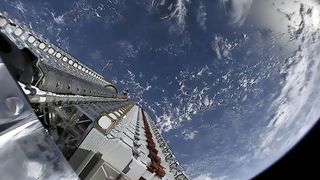Starlink nearing FCC approval for 4,000 low-orbit satellites — rivals fear collision risks
Starlink nearing FCC blessing for 4,000 low-orbit satellites — rivals fear collision risks

The Federal Communications Commission (FCC) is inching closer to giving SpaceX the ability to fly its Starlink satellites at an even lower orbit.
The report comes via Bloomberg, which states the acting FCC chair, Jessica Rosenworcel, is urging members of the commission to vote for the program. If canonical, it would movement Starlink's 2,824 satellites currently in orbit to move from 1,000 kilometers above the Earth's surface downward to 550. This would put Starlink's satellites just below Amazon'south Project Kuiper satellite internet constellation, which it plans to accept orbiting 630 kilometers in a higher place the Earth'southward surface. This even lower-Earth orbit (LEO) would allow Starlink to offer increased speed as signal would need to travel half as far.
- Starlink review
- These are the best Wi-Fi routers available right now
- Plus: Watching mobile YouTube videos merely got more confusing — here's why
SpaceX had already gotten approval to permit 1,584 Starlink satellites to operate in the 540 to 570 kilometer range. If the FCC grants this additional approval, so 4,408 satellites could occupy this zone.
Of course, SpaceX and the FCC are getting button back from other satellite cyberspace companies. Non but is Amazon's Project Kuiper competing against Starlink, and so is Viasat Inc., Telesat Canada and OneWeb.
"Information technology's like a bomb going off," said John Janka, Viasat's chief officer for global regulatory and government affairs said in an interview before the FCC. "The satellites fragment, and and then pause into little pieces. And the droppings spreads hundreds of miles."
It'south non just the competition that'south citing business, so is the European Infinite Agency. It estimates that there are thousands of large pieces of space droppings currently orbiting the Earth. The worry is that with thousands of competing satellite constellations, the risk for a collision increases. Those thousands of pieces of space debris could surge into the millions. Per NASA, electric current space debris has a full commonage mass of half dozen,000 tons.
Outcry from astronomers has already prompted SpaceX to reduce the luminosity of its Starlink satellites. Still, according to an interview with John Barentine, director of public policy at the International Dark-Sky Association with the Washington Mail service, the satellites are still besides bright, past "a factor of more than two."
Autonomously from billionaires arguing about their satellites, this lower-Earth orbit Starlink constellation should mean increased speeds for customers.
- More than: Starlink aiming for total launch this summer — what you need to know
Source: https://www.tomsguide.com/news/starlink-nearing-fcc-approval-for-4000-low-orbit-satellites-rivals-fear-collision-risks
Posted by: byardhingently.blogspot.com


0 Response to "Starlink nearing FCC approval for 4,000 low-orbit satellites — rivals fear collision risks"
Post a Comment